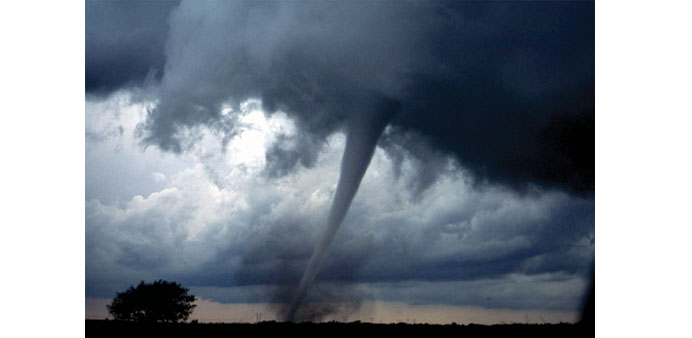By Steff Gaulter
Huge tornadoes have swept across the US causing widespread damage and endless heartache. The devastating twisters rolled through Illinois, Iowa and Missouri, the states just to the southwest of the Great Lakes, on April 9. A total of sixteen tornadoes were reported, which made it the largest outbreak in the US so far this year.
The majority of the tornadoes were from one single storm cloud. As you can imagine, it had to be an enormous storm to generate such a large number of tornadoes, and this type of system is known as a ‘supercell’. Supercells are highly organised thunderstorms which often produce large hail and damaging winds. In this case, the supercell generates not only giant hailstones, but also a large number of tornadoes.
In the evening of April 9, one of the twisters roared across the plains to the northwest of Chicago. A small village called Fairdale sustained the majority of the damage, with every single structure reportedly being damaged and many of them being completely destroyed.
The tornado responsible measured just under a kilometre, or half a mile, across and travelled along the ground for 25 to 30 km (15 to 20 miles). For a tornado, this is a long way, and thankfully very unusual. However, for the residents of Fairdale, its rarity was little consolation.
As well as being long lived, the tornado was also powerful. The exact strength of the winds is unknown as a tornado is unlikely to travel over an anemometer, which measures wind, and even if it did, the winds would probably break it! Instead an estimation of the wind speed is calculated, based on the damage that it leaves behind in its wake. In this case, some of the houses in Fairdale were swept off their foundations, so the storm was estimated to be an EF4 tornado. This is one notch below the most severe classification on the Enhanced Fujita scale, which is used in the US to measure their strength. This would mean that the winds would have been between 290 and 320 kph (180 and 200 mph), and with winds that strong, it’s a wonder that only two people were killed.
The two people who lost their lives were neighbours, which is no surprise. Tornadoes are relatively small features, no more than 1.5 kilometres across (1 mile), and therefore their impact is usually very localised. Their small scale, and the fact that many complex process lead to their formation, also ensure that they cannot yet be forecast. In fact, it is fair to say, with our current models and the limitations of computer power, that accurate predictions of a tornado is still a long way off.
Instead, the best a weather forecaster can do, is to say that certain conditions are conducive to the development of tornadoes, and look out for these conditions. Then on a day when those conditions are present, meteorologists will keep a close eye on their radar screens and look for a storm which develops a rotation. This rotation is the tell-tail sign that a storm is threatening to produce a tornado and the forecaster will then issue a warning for the towns ahead of this storm.
The forecast of a tornado is therefore still fairly rudimentary, but twisters are more common than most people think, in fact I’ve even seen a photo of a tornado here in Qatar. Every single continent has seen a tornado, with the exception of Antarctica. Whether that’s because there are very few people in Antarctica to see it, we can’t be certain. However, as tornadoes are triggered by the interaction of two contrasting air types, it seems unlikely, as there is no source for the warm air.
Thankfully, the vast majority of the world’s tornadoes are pretty feeble and don’t cause a lot of damage. The US, however, sees some of the most powerful ones due to the battle between two very different types of air. In the south is the warm and humid air which flows up from the Gulf of Mexico, and in the north is the icy cold air which jets down from Canada. Where these two airmasses meet is the setting for some of the most destructive weather that we see, and the greater the contrast in temperature, the more explosive the result.
The tornadoes in the US can occur in any month, but they are most common in late spring. This is when the region is recovering from its bitter winter, so not only is the contrast between the frigid northern air and the tropical southern air most pronounced, but also the ground is heating up quickly, giving extra energy to the atmosphere and the weather. More energy produces more severe weather.
Unfortunately it’s almost certain that this won’t be the last outbreak of thunderstorms that the US sees this year. As the winter finally begins to relinquish its hold on North America, and the temperatures begin to rise, the weather will also turn more violent.

POWERFUL: File photo of a tornado near Anadarko, Oklahoma. Photo by Daphne Zaras


